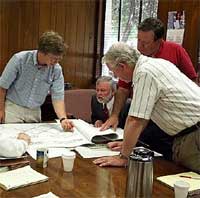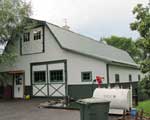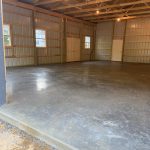In most cases one never considers the background of the people who will be doing plan reviews and field inspections for their new post frame buildings. For those with inquiring minds, I stumbled across this data, which I will share.
In August 2014, the International Code Council (ICC) published “The Future of Code Officials: Results and Recommendations from a Demographic Study.”
This study reveals a typical code professional is between the ages of 55 and 64. He or she is a jurisdiction employee rather than an employee of a third-party provider and works in a one- to nine-person department which serves a community of fewer than 75,500 people.
 A typical code professional earns between $50,000 and $75,000. (The median household income in 2012 was $51,017 according to the U.S. Census Bureau.) He or she has between 26 and 35 years of experience in the building industry but only five to 15 years as a code official.
A typical code professional earns between $50,000 and $75,000. (The median household income in 2012 was $51,017 according to the U.S. Census Bureau.) He or she has between 26 and 35 years of experience in the building industry but only five to 15 years as a code official.
A code official typically enters the code profession while in his or her 30s and held between one to three jobs before becoming a code professional. His or her first job was a tradesperson. A code official may possess a bachelor’s degree (27 percent) or may not have pursued additional education beyond high school (25 percent). If a code official has a bachelor’s degree, the degree probably is in engineering, but it could be in management, accounting, finance, etc.
A code official currently does not hold any trade licenses but does have a professional license, certificate, certification or other credential. His or her most likely reason for pursuing a job as a code official is job security. His or her current role as a code official is an inspector, plan reviewer or department manager.
Given the relatively small size of a typical department, it is likely he or she may simultaneously serve in some or all these roles. Most code professionals expect to leave the building regulatory profession within the next five to 15 years.
Looking for a career change where every day brings new and interesting people and projects? If so, becoming a Building Official might be the ticket!









Advise to customers. When you receive your plans take them to a engineer for review. The pole building I purchased from Hanson in 2016 does pass code, however when I spoke with the Hanson salesperson on the phone I made it very clear that I wanted a HEAVY DUTY building, I received the plans and my fault that I approved them. The package was delivered and to my surprise I observed that the support posts were 5 1/2″ X 3 1/2″. I had been under the impression that minimum for a heavy duty building would be at least 6×6 posts. The building is hardly what I would consider HD. Probably standard back east but not where I live. I had made it very clear that I wanted a HEAVY DUTY structure at the time of ordering.
In all fairness, I have myself partially to blame for not catching the post size when I approved the plans. I had no idea someone would include these small posts in what was to be a HD building.
One of the other buildings I put up on my property from another supplier was actual heavy duty, those posts were 6″ x 10″.
I do partially blame Hanson buildings because they did not listen when I stipulated a HEAVY DUTY building. It’s now 2018, I am still upset about this. I have two other buildings to put up on the property in the next few years and they won’t be from Hanson buildings. They did not listen!
We do absolutely listen to every client’s concerns and take them to heart. In this case, the order for the building was approved by you on February 9, 2017, plans were sent to you for review and accepted six days later.
On March 7 our Technical support Department received this email from you:
“When I originally talked with Mike I wanted a heavy duty building, It seems
no one there was listening, I have my plans and the roof trusses show 2×4
construction and side posts 3.5 x 5.5, I am very concerned that this is a
very weak design. I know I already approved the plans but I will have to
spend bout 4000.00 more to locally tp purchase 6×6 posts and 2×6 trusses. I
guess I can sell the ones I receive. You people must think I live near
Seattle, not, I live on the eastern slope of the Cascade mountains, your 2×4
double truss design appears obviously not strong enough to take the snow
loads in my area. I am very concerned.”
To which the following response was given by me:
“We take our client’s concerns to heart, it is part of why every Hansen Pole Building is structurally designed by a registered professional engineer.
In review of your building plans, I see it has been designed to meet or exceed a roof snow load of 45 psf (pounds per square foot) as well as an ultimate wind speed of 100 mph (miles per hour). The calculations for each and every member and connection on your building have been thoroughly reviewed by a Registered Design Professional (the engineer who seals your plans). I would venture a guess your Building Department has approved the plans as meeting the structural requirements.
The prefabricated roof truss designs for your building utilize 2×6 1650msr (or stronger) lumber for the top and bottom chords. When you go to your local lumberyard to purchase a 2×6 graded as #2 (the standard for framing throughout the industry). It has a bending strength of from 1105 to 1170 psi (pounds per square inch), depending upon the species of lumber. The 1650 msr being used for your truss top and bottom chords is at least 41% greater in bending strength. The interior members of the trusses (the webs) are indeed 2×4, as they would be in virtually any truss design. In truss configurations, the webs carry minimal loads for both compression and tension and are loaded to only 75% of their capacity on the interior double trusses. If your trusses have not yet been fabricated, it is possible we could upgrade to 2×6 webs, however the load carrying capacity of the trusses would not be increased by this change – you would basically just be spending money to spend money.
On to the column sizes. I’ve written extensively in the past on why a 4×6 (3-1/2″ x 5-1/2” actual) sized column will outperform a 6×6 column in most cases. If you would kindly take just a few moments to read about it here: https://www.hansenpolebuildings.com/2014/08/lumber-bending/.
Things I do know – your building, built according to the engineered plans, will support the loads given, not only is it an engineered building, but we also provide a limited lifetime warranty to back it up!
I did a few trial calculations, increasing your roof snow load to up to 180 psf (four times what you invested in). Even at this load, 4×6 columns still work! The column is not “the weak link”.
Provided your lumber package is not ready to be shipped and your trusses have yet to be fabricated, it might yet be possible to increase the design roof snow loads, and/or the design wind speed beyond what the Code requirements are. In doing so, this again checks every member to insure you have no weak links.
If you desired to increase both by 25% (Ground snow load to 75, roof snow load to 56.25 and Vult to 112 mph) you would be looking at an up charge of $1580 and would receive new sealed plans and truss drawings to confirm these loads. An increase of 50% (Pg = 90, Pf = 67.5, Vult = 122.5) would be $2765. Either of these would, of course, be depending upon the status of your building in the production processes.
We will await hearing back from you as to your wishes.”
Not until April 21 (after all materials had been delivered) did we hear back from you with basically the same concerns as voiced earlier. We offered the opportunity to increase the design loads and provided a couple of examples, however you made the choice to accept materials as designed by the engineer of record.
Your advice to take engineered plans to another engineer for review might sound good, but the reality is you would have paid for something you already paid for and it would not have made a change in the building as designed. My encouragement always to any client who has concerns about any climactic load – wind, snow or seismic, is to opt for the small investment to support a design load greater than the Code requirements.